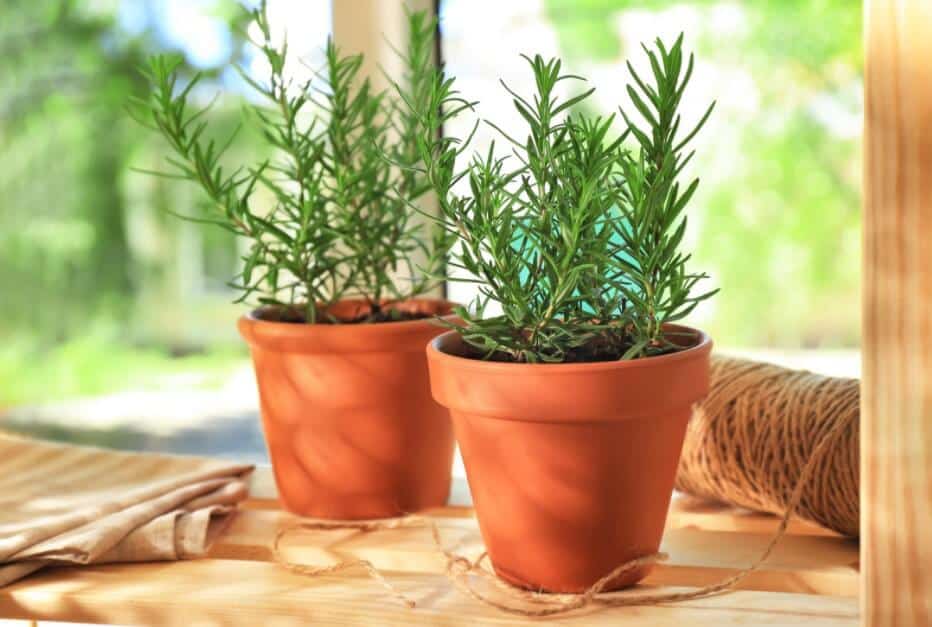How to Grow Rosemary At Home (A Beginner Guide)

Rosemary is one of the most common herbs, either in culinary or herbal remedies. This thin bushy herb plant has that aromatic flavor and scent, which helps elevate your dish or give your room a fresh smell from its flowers.
In terms of visual appearance, rosemary is a woody, evergreen shrub herb with thin leaves similar to cypress leaves. Rosemary could be a very bushy herb plant once grown in the right way and planting environment.
Additionally, rosemary goes very well for basting steak, lamb, or pan-seared beef with butter and garlic. However, rosemary also blooms flower in which scent is very delicate.
Not only for flavor purposes, but people are also interested in rosemary because of its health benefits. Did you know that rosemary is very rich in antioxidants and anti-inflammatory?
Those are thought to help boost the immune system and improve blood circulation.
Notice that you can get so many advantages from rosemary. It’s good news that you can now grow your rosemary at home! Yes, it is very straightforward to plant rosemary, either indoor or outdoor.
Also, always stick in mind that you have to pay attention to the soil, light, and water. Here is your ultimate guide on how to grow rosemary at home.
How to Grow Rosemary
There are two ways of growing rosemary; either you grow it from seed or cuttings. Growing it from seed means you plant the seed and treat the seeds until it grows to be a rosemary bush that you can harvest.
Meanwhile, growing it from cutting means you plant the stem from the previously grown rosemary. You can cut it yourself, but groceries also sell rosemary stems for you to produce.
If you want to have a more comfortable and faster way, you’d better grow your rosemary from cutting. Planting rosemary from seed requires a longer time for it to grow. Moreover, germination in rosemary does not always come easy.
Indoor or Outdoor?
After deciding which way you want to execute to plant rosemary, now you choose where to grow it. Rosemary is a friendly herb that you can plant indoor or outdoor, though.
The best way to plant rosemary indoor is by growing it in a container. Once your rosemary is in the container, you should make the plant to acclimate the different light it could get indoor and outdoor.
Rosemary loves full sun, and even the brightest sun under the window is not the same as direct light.
You can start acclimating the rosemary by putting it outdoor in a shadier garden for part of the day if you have time. That way, the plant can adapt to the light.
As for outdoor, you can directly plant your rosemary stems once you got the soil in the garden.
Be mindful of giving a distance of about 2 or 3 feet with other plants because rosemary could grow tall and bushy.
Soil
The best kind of soil to plant rosemary is friable and well-drained ground. The texture must be sandy, and it’s okay to have your soil a little bit rocky.
Make sure the soil has enough air and proper drainage. Bear in mind that you should never overwater the rosemary.
Therefore, you should consider the water drainage in your container if you plant indoor.
Light
Light is one of the essential things in planting herbs. As for rosemary, it’s best to give full sunlight every day.
Getting full sunlight exposure is easy when growing it outdoor. What if you do it indoors? Well, you can trick it by putting your rosemary in a bright window with access to sunlight. The more sunlight, the better it would be.
Another way for you to acclimate rosemary with indoor light is by giving it proper acclimation.
How?
By moving your container outdoor in the shady garden for a few hours or part a day. Afterward, you can move your potted rosemary inside.
Water
Guess what element that grows the plant from the root? You don’t say.
Watering rosemary can be a bit tricky if you plat it indoors. It would be best if you watered it once the soil is completely dry. Otherwise, you’re going to create soggy soil that might be an issue to your herb gardening.
As for outdoor, the rule is the same to keep the soil well-drain and not to overwater it. Even rosemary tend to die overwatered than die drought.
Pro-tip, gently misting your rosemary every ten days to fill the gap between minimum waterings.
Temperature
tolerates high temperature. However, it doesn’t tolerate extremely low temperatures as that would trigger powdery mildew.
Therefore, planting rosemary outdoor is okay, but you cannot let your rosemary be outside when the temperature is below 30 degrees Fahrenheit.
Since rosemary likes dry soil and environment, growing it indoors is practicable during all seasons, yes winter’s included. Just be sure the plants don’t bake and completely dry out while outdoors during the summer.
Fertilizer
Let’s grow the best rosemary in the house, shall we? Fertilizing your rosemary is not compulsory, but giving it kelp or fish emulsion will make it look great and bushy.
Additionally, liquid fertilizer is also an excellent option to feed rosemary. Nevertheless, be mindful of using chemicals if you intend to use your rosemary for food purposes. Use compost instead!
Harvest & Propagation
Harvesting time! Rosemary is a very flexible and friendly herb that you can harvest its stems at any time when it’s grown. You can cut the stem off of the plant, but not the entire plant.
For food and flavor purposes, some people tend to dry rosemary instead of putting it fresh. To dry it, you can tie some rosemary stems and hang them upside down.
When it’s dried out, you can take the leaves and pour them into your dish for an aromatic and savory flavor.
If you tend to use fresh rosemary, no worries1 Fresh rosemary goes very well for beef basting. Mix it with hot butter or oil, and voila! You get that punchy flavor for your pan-seared.
Another pro-tip can preserve rosemary in vinegar after propagating it and use it later with butter or olive oil to flavor it.
Troubleshooting the Pest
Notice that rosemary is a living plant, herb; moreover, it is always possible to have some pests coming.
Some insects like whiteflies, spider mites, scale, and mealybugs can all bother rosemary. Once you see those insects in your rosemary plants, spray them with water. Some other pests like aphids need more rigid spray, though.
When you try to grow it from cuttings or seed, the enemy of rosemary is not only those insects but also the mildew and root rot from the humid environment.
How to prevent them from happening? Simple! Be mindful of the water and soil rule, which is not to overwater it and keep the environment well-drained. The air circulation from friable soil could also help to prevent mildew.
Conclusion
So, those are the things you want to consider how to grow rosemary in your house, either indoor or outdoor. I believe it is easier than you thought.
The essential rules for growing rosemary are simple;
- One, use well-drained and moist soil to plant it.
- Two, be mindful not to overwater your rosemary.
- Three, make sure to get your rosemary full-sunlight and acclimate outdoors or if you decide to do it indoors.
If you make those three points right, you are going to successfully grow a great bushy evergreen shrub herb in your house. Give yourself a try!
